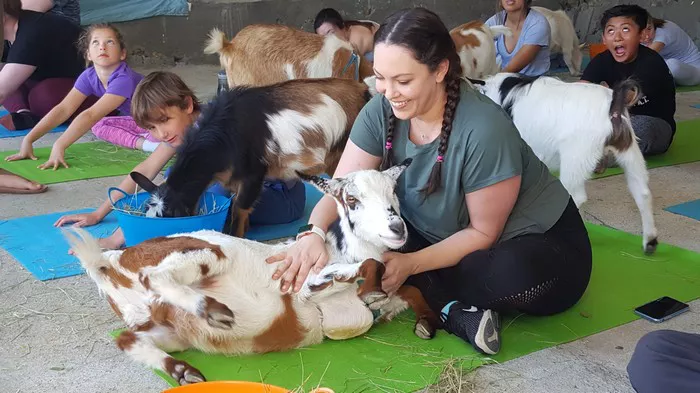Goat yoga, a unique fusion of traditional yoga practice and animal interaction, has gained significant popularity in recent years. The sight of goats playfully mingling with yogis during sessions has captured the hearts of many. But amidst the growing enthusiasm, an important question arises: do goats actually like goat yoga?
Understanding Goat Behavior and Needs
To assess whether goats enjoy participating in goat yoga, it’s essential to understand their natural behavior and needs. Goats are social, curious animals known for their playful and sometimes mischievous behavior. They are herd animals, meaning they thrive in groups and exhibit strong social bonds. Their well-being is closely tied to their ability to interact with their peers and engage in activities that stimulate their curiosity and physical energy.
In their natural habitat, goats spend their days foraging, climbing, and exploring their environment. They are agile creatures with a penchant for climbing on elevated surfaces, a behavior that has endeared them to goat yoga participants when goats climb onto their backs during sessions. Additionally, goats communicate through vocalizations, body language, and scent marking, which are crucial for maintaining social order within the herd.
Evaluating the Goat Yoga Environment
The typical goat yoga environment is designed to be safe and comfortable for both humans and goats. Sessions are usually held in outdoor or barn-like settings, providing ample space for goats to move around freely. The presence of soft mats and props offers surfaces for goats to climb and interact with, mimicking their natural inclinations.
Moreover, goat yoga sessions are often structured to be relatively short, typically lasting around an hour. This duration ensures that goats are not subjected to prolonged periods of human interaction, which could potentially become stressful. Additionally, many goat yoga practitioners work closely with animal behaviorists and veterinarians to ensure the health and welfare of the goats involved.
Indicators of Goat Enjoyment
Observing the behavior of goats during yoga sessions can provide valuable insights into whether they enjoy the experience. Several indicators can suggest positive engagement and enjoyment:
1. Playful Behavior: Goats are naturally playful animals. During yoga sessions, if goats exhibit behaviors such as jumping, climbing, and frolicking around the participants, it can be an indication that they are enjoying themselves. Playful nibbles and gentle head butts are also signs of positive interaction.
2. Social Interaction: Goats thrive on social interaction, not only with their herd members but also with humans. If goats willingly approach participants, seek attention, and engage in physical contact, it suggests they are comfortable and enjoying the social aspect of the activity.
3. Relaxed Posture: A relaxed goat is one that feels safe and content. Signs of relaxation include lying down, chewing cud, and soft bleating. During goat yoga sessions, if goats exhibit these behaviors, it indicates they are at ease and not experiencing stress.
4. Curiosity and Exploration: Goats are naturally curious animals. If they actively explore the environment, investigate yoga mats, props, and participants, it suggests they are stimulated and find the environment enriching.
Potential Stressors for Goats
While many goats may enjoy the novelty and interaction provided by goat yoga, it’s important to recognize potential stressors that could negatively impact their experience:
1. Overcrowding: An overcrowded environment can cause stress for goats. Ensuring that the number of participants is balanced with the number of goats present is crucial to avoid overwhelming the animals.
2. Excessive Handling: While goats may enjoy gentle interaction, excessive handling, especially by unfamiliar individuals, can lead to stress. It’s important to allow goats to initiate contact and respect their boundaries.
3. Loud Noises and Sudden Movements: Goats are sensitive to their surroundings. Loud noises, sudden movements, or overly enthusiastic participants can startle them. Maintaining a calm and controlled environment is essential for their well-being.
4. Inadequate Rest Periods: Just like any animal, goats need time to rest and recuperate. Ensuring that they have adequate rest periods between sessions is vital to prevent exhaustion and stress.
The Role of Training and Acclimatization
To enhance the enjoyment of goats in yoga sessions, proper training and acclimatization are key. Gradually introducing goats to the yoga environment and familiarizing them with the presence of humans can help reduce potential stress. Training goats to be comfortable with being handled and to associate the yoga environment with positive experiences can further enhance their enjoyment.
Animal behaviorists often recommend using positive reinforcement techniques, such as treats and praise, to reward goats for calm and positive behavior during sessions. This approach not only helps in training the goats but also strengthens the bond between the animals and the participants.
Ethical Considerations and Best Practices
While the goal of goat yoga is to create a joyful and relaxing experience for both humans and goats, it is essential to prioritize the welfare of the animals. Adhering to ethical considerations and best practices is crucial to ensure that goats are not exploited or subjected to undue stress.
1. Qualified Supervision: Having a qualified animal handler or veterinarian present during sessions can help monitor the well-being of the goats and address any potential issues promptly.
2. Limitations on Session Frequency: Limiting the number of yoga sessions each goat participates in per week can help prevent burnout and ensure they have ample time to rest and engage in natural behaviors.
3. Participant Education: Educating participants about appropriate behavior around goats, such as avoiding loud noises and sudden movements, can create a more harmonious environment for the animals.
4. Regular Health Checks: Regular veterinary health checks are essential to monitor the physical well-being of the goats and address any health concerns that may arise.
5. Voluntary Participation: Ensuring that goats are not forced to participate in yoga sessions is fundamental. Allowing them the freedom to move in and out of the yoga space at will ensures that their participation is voluntary and based on their comfort level.
Conclusion
In conclusion, whether goats like goat yoga depends on various factors, including their individual personalities, the environment, and the way sessions are conducted. Many goats appear to enjoy the interaction, playfulness, and stimulation provided by goat yoga, as evidenced by their behavior during sessions. However, it is crucial to prioritize their welfare, ensure proper training and acclimatization, and adhere to ethical practices to create a positive and enjoyable experience for the animals.
By respecting the natural behaviors and needs of goats, practitioners can ensure that goat yoga remains a joyful and enriching activity for both humans and goats alike. As with any animal-assisted activity, the key lies in maintaining a balance that prioritizes the well-being of the animals while providing a unique and delightful experience for participants.














